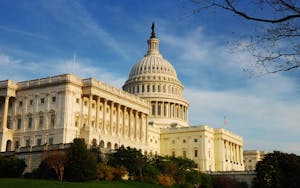
IIJA at the midway point: Act now to secure these funding opportunities
Introduced in 2022, the Infrastructure Investment and Jobs Act (IIJA) has proven to be one of the most significant pieces of federal legislation in U.S. history. And though we’re nearly halfway through the IIJA timeline, a significant amount of funding is still available for the remainder of this year, next year and 2026.
It’s important to keep in mind, however, that while a large portion of this funding is earmarked for public sector entities, a common theme throughout IIJA opportunities is a strong focus on assisting small and disadvantaged communities.
Whether you’ve already begun exploring your IIJA possibilities and need additional guidance, or you’re simply late to the party (better late than never!), we’ve broken down what you need to know about the IIJA to take advantage of these potential incentives and funding.
The IIJA allocates $14.65 billion for drinking water projects over a five-year period—with most of these dollars going through local State Revolving Fund (SRF) programs. Yearly totals are as follows:
- $2.4 billion in 2022
- $2.75 billion in 2023
- $3 billion in 2024
- $3.25 billion in 2025
- $3.25 billion in 2026
In addition to the funding opportunities above, there’s also $15 billion dedicated to lead pipe replacement projects and roughly $30 to $50 million per year targeting lead contamination in school drinking water.
Alongside drinking water projects, an identical amount of funding has been purposed for qualifying wastewater projects ($14.65 billion over the same five-year period). Though, as with drinking water, there are additional caveats and opportunities for wastewater projects, including:
- Stormwater projects also qualify for low interest loan funds
- $5 billion (all in grants) set aside for projects concerning emerging contaminants (think PFAS)
- $5 million per year for workforce training and development
- Grid Resilience and Innovation Partnerships (GRIP) Program—focused on grid resilience, smart grid capabilities and grid innovation
- Additional program for preventing outages and enhancing resilience in electrical grids (advanced in light of recent events)
- Energy Improvements in Rural and Remote Areas (ERA)—for energizing rural communities prize, ERA funding opportunity and ERA fixed award
- Charging and Fueling Infrastructure Grant program
- Drinking Water System Infrastructure Resilience and Sustainability program (for which another round of funding is coming out in the spring of 2024)
When considering the above grants—and additional IIJA opportunities—it’s important to know that many require a Community Benefits Plan (CBP). These CBPs often require overall organization engagement which necessitates a large amount of people working together to properly execute. As you’re writing these grant programs keep this potentially daunting task front of mind—especially since most organizations need assistance with compiling their CBPs.
Quite simply, the Justice 40 Initiative is designed to pursue one goal: ensuring that 40% of the overall benefits of certain federal investments will flow into communities that are marginalized, underserved and overburdened with pollution. The initiative prioritizes projects that focus on:
- Clean transit
- Climate change
- Clean water and wastewater
- Affordable and sustainable housing
- Clean energy and energy efficiency
- Training and workforce development
- Remediation and reduction of legacy pollution
The big picture
Whether you’ve explored IIJA opportunities in depth, or you’re putting together your very first competitive grant proposal, it’s crucial to remember the broad, overarching goals of the IIJA, as follows:
Creating more jobs
- Most applications require a discussion of how many jobs the project is anticipated to create
- A focus on quality, well-paying jobs (in line with Davis-Bacon wages, benefits, etc.)
Supporting rural communities and tribal nations
Sets aside funding for tribes and programs specifically targeted to rural areas
Environmental protection
Including, but not limited to, environmental remediation and pollution reduction
Resilience and climate change initiatives
Not just providing reliable service, but preparing for climate change and more extreme weather events that could disrupt future service
The bottom line? Never lose sight of the IIJA’s most critical aims: to improve U.S. energy, environment and infrastructure and to improve U.S. manufacturing, economy/workforce and equity.
Considering your IIJA possibilities? Time may be running out—but you still have plentiful funding opportunities to explore. When you’re ready, we’re ready.
More to explore
In addition to the IIJA timeline, there is tremendous incentive to begin your Inflation Reduction Act (IRA)-eligible projects sooner rather than later—not only to maximize the available IRA funding but to avoid the stricter requirements (and potential tax credit reductions) that take effect further down the line.
And while you may be considering the IRA’s expanded funding opportunities, we realize you may have unanswered questions:
- Why is the direct pay provision such a game changer?
- How might prevailing wage, apprenticeship and domestic content incentives/requirements impact my organization?
- What about the energy community bonus?
- How, where and when do I get started?
Fortunately, we’re here to help. In the latter half of our recent webinar, after exploring all things IIJA-related, we dive deep into the IRA itself. We discuss the above topics, common outstanding questions and possible next steps. Access the on-demand recording below to learn explore both IIJA and IRA opportunities for your organization.
More Inflation Reduction Act (IRA) insights
Baker Tilly Municipal Advisors, LLC is a registered municipal advisor and controlled subsidiary of Baker Tilly Advisory Group, LP. Baker Tilly Advisory Group, LP and Baker Tilly US, LLP, trading as Baker Tilly, operate under an alternative practice structure and are members of the global network of Baker Tilly International Ltd., the members of which are separate and independent legal entities. Baker Tilly US, LLP is a licensed CPA firm and provides assurance services to its clients. Baker Tilly Advisory Group, LP and its subsidiary entities provide tax and consulting services to their clients and are not licensed CPA firms. ©2024 Baker Tilly Municipal Advisors, LLC





